
Drones often can photograph hot spots more safely than a tech on a ladder can. Photo: Andrew Hicks, Pest Management Systems Inc.
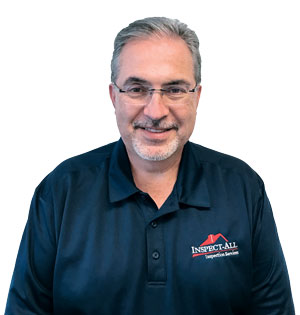
Joe Sheffield, vice president of Inspect-All
Nearly three years ago, when Conyers, Ga.-based Inspect-All Services was looking for ways to improve its approach to roof and building inspections, management looked to the skies: The company has since deployed a pair of camera-equipped unmanned aerial vehicles, also known as drones, to take a closer look at its clients’ rooftops.
“We don’t have to use a ladder, and we can get better views by using the drone,” says Joe Sheffield, vice president of Inspect-All. “We’re also a company that takes pride in embracing technological advancements, and we really see drones as fitting with that core philosophy.”
Inspect-All is not alone. Pest management professionals (PMPs) around the country are taking to the air — using aerial photography drones to enable faster, safer inspections without ladders, and in some cases, to perform other pest management tasks.
Drones are being used for military and civilian applications. Domestically, drones have been used by local police departments and the border patrol for surveillance operations, and have been deployed for search-and-rescue in some states. Amazon has even tested drones for package delivery. Shipments of commercial drones surpassed 100,000 units in 2016, and the market is set to exceed $17 billion in sales by 2024, according to Global Market Insights. The American Association of State Highway and Transportation Officials says 80 percent of state departments of transportation are using drones for a variety of applications, including survey and inspection work.
In pest management, drones already have been deployed for bird control and inspections, and additional applications likely will follow. For bird control, drones can be used to conduct surveys and to clear buildings or farms of pest birds, sometimes by imitating predators. One drone on the market even features a built-in “sonic bird repeller.” More commonly, PMPs are using drones for property inspections. By using a camera mounted on a drone to inspect the upper levels of residential and commercial structures, PMPs can save time and reduce the likelihood of ladder accidents.

Judy Black, BCE, vice president of technical services at Rentokil Steritech
“The use of drones is really on the cusp of expanding,” says Judy Black, BCE, vice president of technical services at Rentokil Steritech. Although Rentokil currently is not using drones in North America, Black notes, it has used them in other markets around the world. In Brazil, for example, the company used a drone and a thermal imaging camera to identify a mouse infestation in an agricultural field for a client that needed to identify the source of rodent hairs in its products.
Faster, safer views
Drones provide two key benefits for PMPs: safety and efficiency. For any activity that might require a ladder — checking a roof or soffit for an infiltration point or termite damage, for example — a drone can be a safer option.
Drones can complete a full roofline inspection faster than sending a technician up a ladder, or moving a ladder around a building to get multiple views. A drone also can quickly deliver live video and take multiple still images in just a few minutes.
For some applications, the drones also keep technicians out of harm’s way when it comes to checking for dangerous animals or insects. Last year in the Channel Island of Jersey, part of the British Isles, the Department for the Environment used a heat-seeking drone to inspect a nest of Asian giant hornets (Vespa mandarinia). The drone was swarmed by an estimated 6,000 of the highly venomous insects as it took still images and video.
“It saves us time and manpower, and it’s safer because you don’t have a guy climbing up a ladder,” says Billy Tesh, a PMP Hall of Famer and president of Pest Management Systems in Greensboro, N.C. Tesh, who serves as the licensed drone operator for his company, has been using the technology for four years.
Tesh uses the drone for inspections to search for entry points for bats and squirrels. “We can take pictures and look at them on an iPad to get a closer view of things,” he says. “If I’m looking at a commercial building that is 1,700 feet around, it would take a long time to get ladders up and do an inspection on that building. The drone helps us narrow the points we might want to look at more closely, and then we get the ladder or the lift. We’re reducing the risk of falling, and it really narrows the scope of our inspections.”
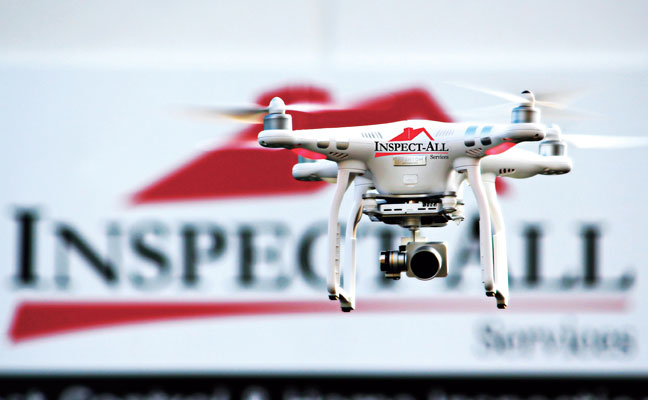
Photo: Inspect-All Services
Drones also can deliver pesticides in some applications. In Japan, researchers at Saga University developed the “agri-drone,” which can spray pesticides on crops with a high level of precision. Farmers in Taiwan and China also are using drones to apply pesticides, and earlier this year, Canadian company Roga Drone received that country’s first permit for the operation of a drone for aerial chemical applications.
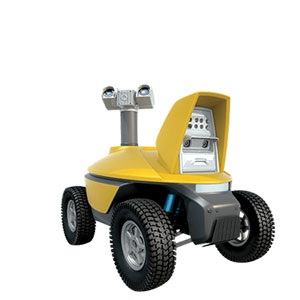
The S3 Mobile Robot from SMP Robotics is an example of a terrestrial drone equipped with a flexible thermal vision camera.
In China, the heat-seeking drones being used to spray pesticides on orchards provide 15 times the efficiency of manual labor — a huge benefit in a country that, despite its large population, has experienced a shortage of farm labor in recent decades. Even retail giant Walmart is getting into the drone business, applying for six patents related to using drones for preventing crop damage, controlling agricultural pests and cross-pollinating plants, in an effort to improve its own fresh produce supply chain.
Using drones to apply pesticides and fertilizers isn’t a huge leap in agriculture. Farmers already rely on Global Positioning System (GPS) and other technologies to automatically guide large farm vehicles during planting and harvesting. The drones used in these applications are larger and more expensive than the type typically used in pest management. The Skyhawk RC X4-10 agricultural drone, for example, costs $5,699.
In Louisiana and California, state officials and private pest management companies have deployed drones to help control mosquito populations, spraying chemicals into standing water. The drones reportedly can cover more ground in less time, which reduces costs and risk, and delivers the pesticide in a more targeted fashion with less environmental impact.
“Any time you are pulling out a ladder, you are increasing risk,” Black points out. “If you could treat a flat roof for mosquitoes, for example, and do that without a ladder, that sounds like a great technology to me.”
While most typically think of only the aerial variety when people talk about drones, a number of pest management and inspection companies also are using terrestrial drones for inspecting crawlspaces and other hard-to-reach areas.
Like their aerial counterparts, these surface vehicles can be used to inspect crawlspaces more quickly and easily, and also can improve safety — robots are less perturbed by unexpected encounters with angry raccoons, skunks or wasps.
A license to fly
For PMPs considering purchasing a drone, there are some regulatory hurdles. The Federal Aviation Administration (FAA) regulates drones for commercial and recreational purposes, and individual states often have their own regulations.
“Every drone has to be licensed through the FAA, and if you are using it for a commercial application there is a test, similar to what you’d take for a private pilot’s license,” Tesh says. “There are airspace considerations too; if you are near an airport, you can’t put the drone up in the air.”
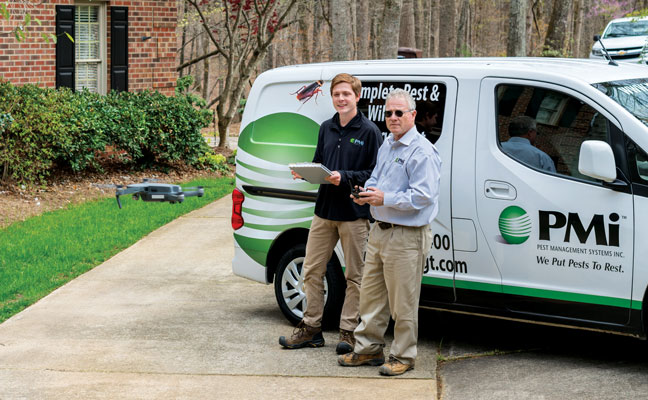
Patrick Thompson (left) and Billy Tesh begin a home inspection with their drone. Photo: Andrew Hicks, Pest Management Systems Inc.
For typical home inspection applications, operators would need a remote pilot certificate from the FAA, and must fly a drone that weighs less than 55 lbs. within visual line of sight during daylight hours, at or below 400 ft. Those requirements were established in the FAA’s Part 107 regulations in 2016. The drones can’t be flown near aircraft or over people, and cannot fly in restricted airspace near airports without notifying the airport operator and air traffic controllers. Part 107 waivers are available for drone flights requiring operation in restricted air space or at higher altitudes.
In commercial applications that may require entry into the National Airspace System, a pest management firm would need a license to operate the drone and an exemption under Section 333 of the FAA Modernization and Reform Act of 2012. Sheffield says the FAA requirements weren’t much of a hurdle. “You get the proper paperwork and get it approved,” he says. “It’s no different than any other regulatory process. You take the classes and pass the test, and you’re good to go.”
Sheffield notes his company’s drone never flies higher than around 100 feet, and that there are some limitations to where they can operate because of their proximity to the Atlanta airport. The drone Tesh uses is monitored with a mobile app that helps him identify when the drone is within restricted airspace. B4UFLY, an app from the FAA, is helpful too.
The size and weight of the drone also will affect its ability to be useful in some applications. “You could potentially drop larvicide into a puddle on the flat roof of a building,” Black says. “But even an ounce change in weight for some of the smaller drones can affect their performance. You’d have to be a really good pilot. If you are using a bigger, more expensive drone, then the weight wouldn’t be noticeable, but you are talking about a big increase in cost.”
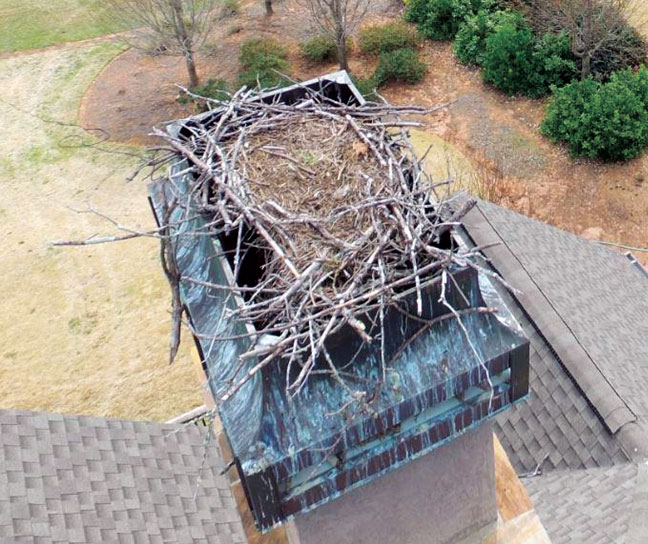
The drones Inspect-All Services’ technicians use feature cameras to find and document problem areas. Photo: Inspect-All Services
Operator error is the biggest daily challenge to drone usage. Inspect-All has two drones in the $1,800 to $2,400 range. If a technician crashes a drone, it might be out of commission. “You have to be prepared for that because mistakes happen, and if the wind kicks up, it can crash the drone,” Sheffield says, who notes that Inspect-All’s drones are insured. “We’ve had situations where the camera was destroyed because of operator error. You really have to be prepared for how you are going to deal with maintenance when a drone goes down. We’ve had to reschedule some inspections because of damaged drones.”
Inspect-All plans to expand its drone fleet, and is looking at new units that cost roughly $1,350 with an accessory bundle, extra battery and hard case. The drone Tesh uses cost roughly $1,200 with accessories. “You’ve got to take wind and weather into consideration before you fly,” he says. “But there are units available now that have sensors to prevent you from getting too close to a building and crashing. The more you pilot drones, the better you get at it.”
PMPs also should keep the privacy of their clients and their neighbors top of mind. Anyone who might be within the drone’s field of view should be notified of the aerial inspection. “A drone is no different than someone on a ladder: In both cases, you have to notify people you’ll be up there,” Tesh says.
Operators also have to take care to not photograph people without permission, and to be cautious about using images captured from a drone on social media.
The FAA regulates drones for commercial and recreational purposes, and individual states often have their own regulations.
Bigger buzz
Sheffield says he believes drones eventually will be used in conjunction with infrared cameras, and that they will become more common in building inspections.
“We’re anticipating drones will take on a much larger role in the commercial arena,” Sheffield says. “I believe that eventually, there will be systems that can use a drone to spot a termite colony in the ground and use infrared technology to treat the whole colony in the ground.”
Tesh says the use of drones will take off. “We’re going to do more. I think the application of drone-delivered pesticides is going to be a big thing in the future. We’re going to see more of these tools implemented in our industry.”
Tesh will have another employee certified to fly the company’s drone within the next year, and wants to expand the use of the drone with his wildlife team. “It’s another
tool in our toolbox,” he says. “It’s not something that is necessarily going to make money for us, but it’s important for improving safety and efficiency.”
I enjoyed this article. I also fly and use my drone for work related issues and construction issues for a contractor. I’m glad to see positive articles about drones. When people misuse drones, it puts a bad taste in everyone¹s mouth. I work for Clarendon Exterminating Company in Manning, South Carolina. I’ve been a aerial pilot for three years.
My latest use of my drone was to check a roof on a 3 story house. Vultures were roosting at night on the roof and causing damage and staining the roof with fecal matter. I use the phantom 3 line of quads and the mavic pro. And when I can use it I use the DJI goggles.